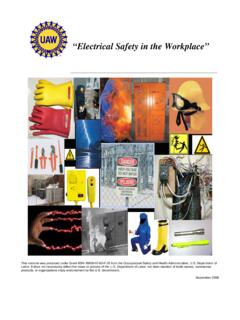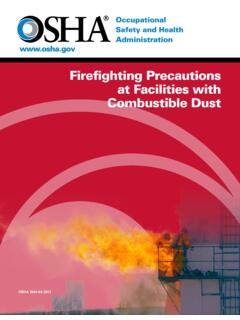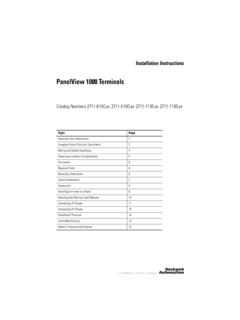Transcription of Standards for the Design, Construction, Maintenance,
1 1 Standards for the Design, Construction, Maintenance, and Use of Laboratory Fume Hoods Document Number: Effective Date: Revision Date: 5/2006 Purpose and Applicability The intention of this document is to set a standard for the design, construction, maintenance, and use of laboratory ventilation in order to maintain acceptable air quality in the laboratory building and surrounding areas. This standard outlines criteria for stack heights, exhaust exit velocities, and design considerations that shall be addressed and implemented at the University of Massachusetts/Amherst. Together with design Standards established by Facilities & Campus Planning, this document will determine requirements for laboratory exhaust ventilation systems. These requirements do not preclude adherence to good engineering practices, the Massachusetts Building Code and Standards referenced therein.
2 These requirements will be included in contract specifications for all future contracts submitted by the University of Massachusetts/Amherst. The University will only accept bids which meet these specifications on future contracts. Definitions The following are frequently used terms regarding Standards for the design, construction, maintenance, and use of laboratory fume hoods: building envelope - the three-dimensional space surrounding a building containing the building s makeup air. downwash - pollutants discharged from an exhaust stack that travel towards the ground due to insufficient discharge velocities, poor wind dispersion, and physical obstructions. exhaust air - the air that is removed from an enclosed space and discharged into atmosphere (ANSI/AIHA , 1992). face velocity - average velocity of air moving perpendicular to the hood face, usually expressed in feet per minute (fpm) or meter per second (m/s) (ANSI/ASHRAE 110, 1995).
3 Glove box - a box-like structure provided with tight-closing doors or air locks, armholes with impervious gloves sealed to the box at the armholes and exhaust ventilation to keep the interior of the box at negative pressure relative to the surroundings (ANSI/AIHA , 1992). hood face - the plane of minimum area at the front portion of a laboratory fume hood through which air enters when the sash/es is/are fully opened, usually in the same plane as the sash/es when sash/es is/are present (ANSI/ASHRAE 110, 1995). internal condensation - fumes and vapors that condense into liquids inside of the exhaust stack. laboratory fume hood - a box-like structure enclosing a source of potential air contamination, with one open or partially open side, into which air is moved for the purpose of containing and exhausting air contaminants, generally used for bench-scale laboratory operation but not necessarily involving the use of a bench or a table (ANSI/ASHRAE 110, 1995).
4 2 lpm - liters per minute (ANSI/ASHRAE 110, 1995). makeup air - outside air drawn into a ventilation system to replace exhaust air (ANSI/AIHA , 1992). Makeup air MUST always be provided when any exhaust system is designed and installed. perchloric acid hood - a fume hood constructed with water wash so it is safe for use with perchloric acid or other reagents that might form flammable or explosive compounds with organic materials of construction (ANSI/AIHA , 1992). recirculation - air withdrawn from a space, passed through a ventilation system, and delivered again to an occupied space (ANSI/AIHA , 1992). reentry - The flow of contaminated air that has been exhausted from a space back into the space through air intakes or openings in the walls of the space (ANSI/AIHA , 1992). replacement air - see makeup air. return air - air being returned from a space to the ventilation fan that supplies air to a space (ANSI/AIHA , 1992).
5 Special purpose hood - an exhaust hood, not otherwise classified, for a special purpose such as, but not limited to, capturing gases from equipment such as atomic absorption, gas chromatographs, liquid pouring or mixing stations, and heat sources (ANSI/AIHA , 1992). variable air volume fume hood - a fume hood designed so the exhaust volume is varied in proportion to the opening of the hood face by changing the speed of the exhaust blower or by operating a damper in the exhaust hood (ANSI/AIHA , 1992). velocity - speed and direction of motion (ANSI/AIHA , 1992). walk-in hood - a fume hood designed to be floor mounted with sash and/or doors for closing the open face (ANSI/AIHA , 1992). Roles and Responsibilities Environmental Health & Safety: Inspects the entire fume hood operating systems including the fume hood, associated duct work, exhaust blowers, and stacks; Places a sticker on fume hoods with average face velocity if the hood operating systems "PASS"; Places a "DO NOT USE" sign on the hood sash if the hood operating system does "NOT PASS"; Puts in a work order on behalf of the department head to Physical Plant for repair; Notifies the Department Head, Department Health and Safety Coordinator, Physical Plant, and Facilities Planning of any hoods which are deemed "OUT OF SERVICE.
6 " 3 Physical Plant and Facilities Planning: In a timely manner, makes all necessary repairs/modifications to the fume hood operating system and any associated equipment which affects the fume hood operating system in order to make the entire system safe to use; Notifies Environmental Health and Safety (EH&S) after all repairs/modifications are completed. EH&S then retests the system; Notifies EH&S on a monthly basis in writing as to the status of repair/replacement of fume hoods based on work orders/work requests submitted. Department Head: Ensures that any fume hoods which are deemed "OUT OF SERVICE" will not be used until notified by EH&S that the hood can be used; Ensures that repairs/modifications are completed in a timely manner to any fume hoods which have been deemed "OUT OF SERVICE"; Notifies EH&S and Physical Plant of any fume hoods which are not operating properly.
7 Personnel Using Fume Hoods: Follow all safety and health procedures specified in the Laboratory Health and Safety Manual and by the faculty supervisor in the laboratory; Attend all required health and safety training sessions; Do not use fume hoods which are "OUT OF SERVICE"; Report fume hoods which are not operating properly, accidents, unhealthy and unsafe conditions to the faculty supervisor; Notify faculty supervisor of any pre-existing health conditions that could lead to serious health situations when using a fume hood. Procedure Laboratory exhaust ventilation systems designed, constructed, maintained, and used at the University of Massachusetts/Amherst shall comply with the specifications and Standards set forth in this document and in the publications listed (see Key References). Failure to meet these Standards shall be referred to the Institutional Chemical Safety Committee (ICSC).
8 Fume Hood Design and Construction The Standards for the Design, Construction, Maintenance, and Use of Laboratory Fume Hoods will concentrate on the aspects of fume hood system design and operation that are critical to protecting the health and safety of faculty, staff, students, and visitors and also minimizing nuisance odors. Properly designed systems function to capture contaminants from the work area and disperse them in the outside environment. Exhaust stacks function to release contaminants from the inside of a building in order to minimize contaminant re-entrainment. The critical design aspects of fume hood systems that are discussed in this document are: the quality of the fume hood enclosure, the quality and quantity of supply air provided to the fume hood, face velocity of the fume hood, exhaust stack height, exit velocity of air being exhausted from the stack.
9 In addition, effluent dispersal is contingent upon factors such as exhaust stack/air intake separation, stack height, stack height plus momentum, topography of the building and surrounding environment, and wind dynamics. 4 Although system performance depends heavily on the above design elements, it must be noted that the fume hood performance in a room is affected by room layout and supply air distribution. System performance depends on the fan and duct layout as well as fan type and discharge conditions. These issues are dealt with in detail in the mechanical design Standards developed by Facilities & Campus Planning (FCP). Laboratory Chemical Hoods: Minimum Specification The design and construction of laboratory chemical hoods shall conform to the applicable guidelines presented in the latest edition of ACGIH s Industrial Ventilation: A Manual of Recommended Practice, and all other applicable local codes, guidelines and regulations.
10 The following are recommended design features for fume hoods: Work surfaces should be recessed at least 3/8 inches below the front edge of the bench or surface. Side and back of the fume hood should have a seamless lip at least 3/8 inches high in order to contain spill. Provide airfoils or other sidewall designs to reduce leakage and airflow eddy at the front edge of the bench and on the front side posts external to the sash. Utilities should be located outside the hood. Other non-electrical utilities, if required, can be located inside the fume hood provided they have outside cut offs and should not subject the operators to exposure from materials inside the hood. Laboratory fume hoods and associated exhaust ducts should be constructed of non-combustible, nonporous material that will resist corrosion. They should be equipped with vertical or horizontal sashes that can be closed, air foils that are built into the fume hood at the bottom and the sides of the sash opening, and baffles to attain a uniform face velocity under different conditions of hood use.




